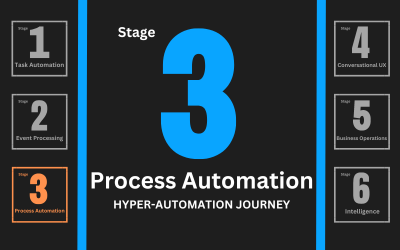Hyper-automation, is a revolutionary approach to business operations, it utilizes a suite of advanced technologies to automate end-to-end processes, resulting in improved efficiency, productivity, and overall operational performance. This transformative journey begins with task automation, progresses through event processing, process automation, conversational UX, digital operations, and ultimately culminates in intelligence. In our previous posts, we discussed task automation and event processing, the first two stages of the hyper-automation journey. Today, we delve into the third stage – process automation.
Understanding Process Automation
Process automation, in the context of hyper-automation, refers to the automation of entire workflows or processes, rather than individual tasks or events. It’s about stringing together a sequence of tasks or events, eliminating the need for manual handoffs, and ensuring seamless transition from one task to another.
For instance, consider the process of onboarding a new employee. This typically involves a range of tasks such as setting up system access, scheduling training sessions, assigning a mentor, and so on. Process automation would streamline and automate this entire workflow, triggering each subsequent task as soon as the preceding one is complete.
So rather than focusing on automating a single task or responding to one specific event, process automation takes a bird’s-eye view and works to automate an entire series of tasks that make up a broader process.
The Significance of Process Automation
Increased Efficiency: By eliminating manual handoffs and automating entire workflows, process automation ensures tasks are carried out more quickly and efficiently.
Reduced Errors: Process automation minimizes the risk of human error by standardizing processes and ensuring they follow a specific set of rules and criteria.
Improved Compliance: With process automation, organizations can ensure every process is carried out consistently, in line with relevant regulations and standards.
Greater Visibility: Process automation provides greater visibility into workflows, making it easier to track progress, identify bottlenecks, and make data-driven decisions.
Implementing Process Automation with ccRobot.ai
ccRobot.ai provides a robust platform for implementing process automation in your hyper-automation journey. Leveraging its advanced AI capabilities, ccRobot.ai can streamline and automate complex workflows, improving efficiency and productivity.
Whether it’s onboarding a new employee, processing an insurance claim, or managing supply chain operations, ccRobot.ai can automate these workflows, ensuring smooth and seamless operations.
Example Process Automation Use Case: ABCompany
To better understand process automation in action, let’s consider a scenario with an e-commerce business called ABCompany.
ABCompany is a growing e-commerce business with a complex order fulfillment process. This process involves several steps, including order confirmation, inventory checking, packaging, shipping, and customer notification.
With ccRobot.ai, we can automate this entire workflow. Whenever a customer placed an order, the system would automatically check inventory, initiate packaging and shipping, and notify the customer, all without any manual intervention. This not only makes the process more efficient but also improves customer satisfaction by ensuring timely and accurate order fulfillment.
The ABCompany example demonstrates the practical significance of process automation as the third stage in the hyper-automation journey. It highlights how businesses can enhance efficiency and customer satisfaction through comprehensive process automation.
Advancing in the Hyper-Automation Journey
With the successful implementation of process automation, organizations take yet another step forward in their hyper-automation journey. After automating tasks, responding to events, and streamlining entire workflows, they are ready to move onto more advanced stages, including conversational UX and digital operations.
Process automation is a vital component of hyper-automation, facilitating the transition from individual task and event automation to a more holistic automation strategy. By effectively implementing process automation, businesses can enhance operational efficiency and productivity, setting the stage for full-scale digital transformation.
Are you ready to take the next step in your hyper-automation journey with process automation? Reach out to us at info@korahlimited.com to learn more about how ccRobot.ai can transform your business operations.

